Microwaves can be tricky for a kitchen designer. They aren’t the belles of the ball nor the cutting-edge appliance du jour. Yet most people use them and need them in a place convenient for everyone. They also come in many shapes and sizes, unlike other appliances. Learn about the four main types of microwaves here and get some tips on how to choose and place them.
Where to Put the Microwave in the Kitchen
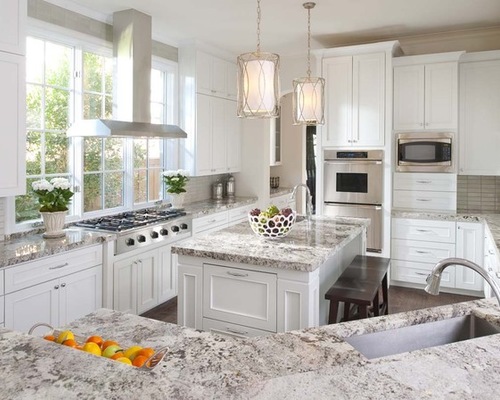
Ellen Grasso & Sons, LLC, original photo on Houzz
Built-In Microwave
What it is: Built-in microwaves include a trim kit that’s often ordered separately. Any size microwave can be built in — large-capacity, high-wattage units or compact countertop units — but the trim kit allows the microwave to look more integrated.
Variations: Built-in microwaves can be installed on their own in a cabinet or above a single oven unit. Trim kits from manufacturers often come in a few sizes, and custom trim kits are also available.
When to use: When specifying a built-in microwave, it’s important to consider the following:
?Will it be located in a place that’s out of the cook’s way but also easy to access? I’ve found that near the refrigerator works best.
?Is there counter space nearby to set hot dishes on?
?Is it at a convenient height for the entire family?
?How deep is the cabinet for the microwave? How does it work with adjacent cabinetry?
?Which way will the microwave door swing? Will the door get in the way?
Tip: Be careful when figuring out the depth of the cabinet for your built-in microwave, and be sure to measure the plug, too. Specs can be tricky, and the depth of the plug might make your built-in microwave not look so built in after all.
Microwaves over built-in ovens look best when they appear to be the same width as the oven below it, which is why you may need a larger trim kit.
You can install a standard microwave in a base cabinet, but you may want to check out microwave drawer options, which are often much easier to use in this location.
Trim kits are available from most microwave manufacturers, but you can also purchase aftermarket kits online for a good price.
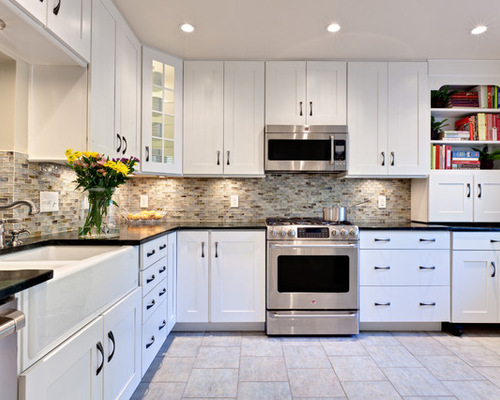
Turan Designs, Inc., original photo on Houzz
Over-the-Range Microwave
What it is: In over-the-range microwaves, the microwave and range hood are one unit. Some of these units vent, while others only recirculate air. These units are around 24 to 30 inches wide and are shallower than full-size built-in microwaves. The shallow size means they can be installed above the cooking surface without causing you to hit your head every time you lean forward to mix the tomato sauce.
Variations: Most of these microwaves are designed to go over a 30-inch range or cooktop and may come with trim pieces to make them look wider. Recirculation and vented options are both available. If it’s a vented model, check the wattage and CFMs (cubic feet per minute) on the hood to make sure you’re getting the right one for your needs.
When to use: If you’re limited on space in your kitchen, this is a good bet. Style-wise, it tends to looks better in an apartment or condo than a single-family home. If you’ve got the space, I recommend installing a stand-alone exhaust fan or hood and putting the microwave in another location. From a design perspective, hoods command a presence and look more substantial over a range than a microwave-hood combo. Plus, microwave-hood combos are often not as powerful, since they have lower CFMs. The same is true of recirculating hoods, which have charcoal filters and don’t actually vent to the exterior.
Over-the-range microwaves are very similar in style and are shallower in depth to fit under a standard wall cabinet. The shallower depth allows for them to be set lower over the cooking surface (24 inches off the cooktop) than a regular hood (30 inches over the cooktop).
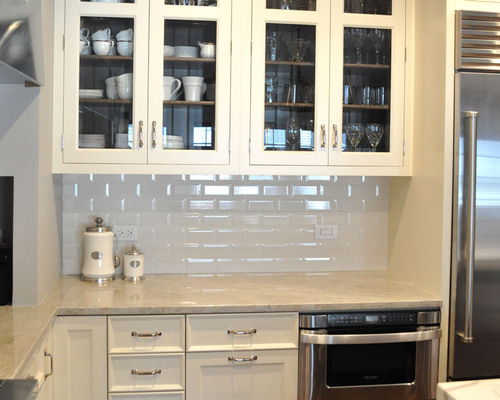
Rebekah Zaveloff | KitchenLab, original photo on Houzz
Drawer Microwave
What it is: A drawer microwave allows for base cabinet installation. Because it pulls out, the buttons are positioned higher, making it more user friendly and easier on your back.
Variations: A few manufacturers now make these, but they’re not hugely different from one another except in style. Typically they come in 24- or 30-inch wide options and fit inside a standard base cabinet. If you’re using cabinets from a stock cabinet company, make one of the cabinets will work with the unit you’ve selected.
When to use: Some homeowners really struggle with microwave location; putting it in the wrong spot can truly ruin the kitchen’s aesthetic. Installing the microwave anywhere below eye level can enhance the design of a wall cabinet or tall cabinet arrangement.
Drawer units won’t ruin the symmetry or aesthetics of a kitchen. Plus, it’s handy to have the counter space right in front of you when you’re handling a hot dish.
A 30-inch drawer unit works very well below a wall oven. The 24-inch versions are more compact and suited for individual base cabinets.
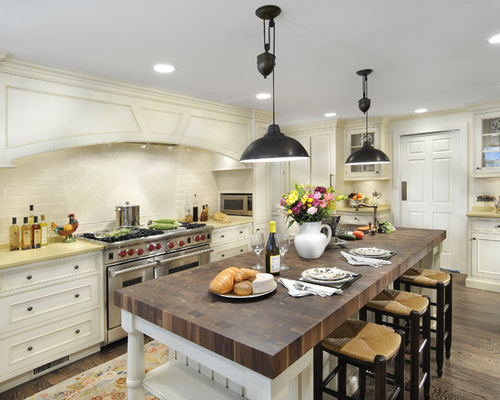
Insignia Kitchen and Bath Design Studio, original photo on Houzz
Countertop Microwave
What it is: These are the traditional, everyday, what-you-grew-up-with sort of microwaves, intended to sit on the countertop and plug right in. You can also use these as built-in units by adding a trim kit.
Variations: Dozens of options for wattage, size and finish are available. There doesn’t seem to be much standardization with this appliance.
When to use: I like to put countertop microwaves in niches, on shelves with cookbooks or hidden away behind a pocket door or pantry door. I rarely put a countertop microwave on the actual counter.
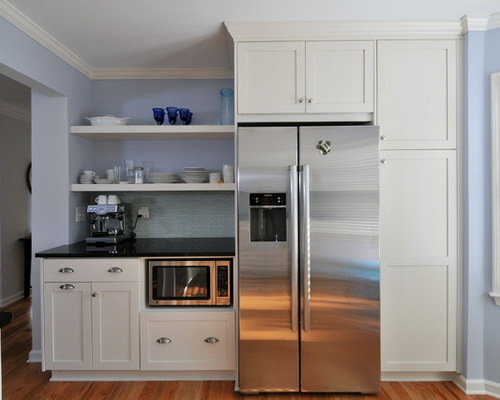
Innovative Construction Inc., original photo on Houzz
This microwave sits simply on a shelf, with open shelves above, creating a breakfast-bar feel.
You could also hide one behind a pocket door or an uphinged door.
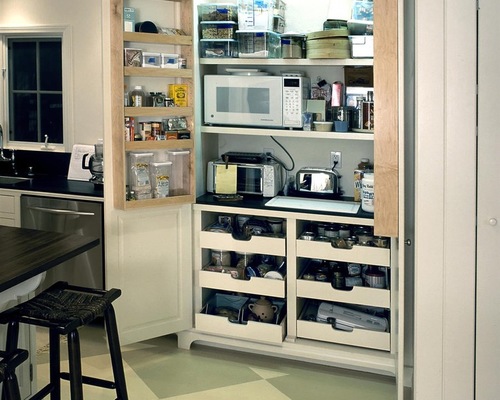
The French Tradition, original photo on Houzz
In my old apartment we had ours hidden in the pantry like this, and I loved it. A small warning about placing a microwave in the pantry: The pantry might end up smelling like the sandwich you warmed up for lunch.
Most manufacturers make countertop microwave models that can be built in or used as stand-alone options.

